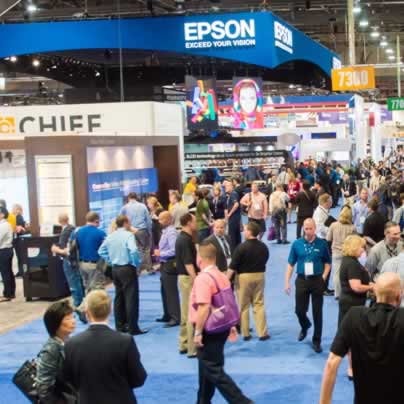At InfoComm 2014 in Las Vegas last week, these four trends stood out

As we noted earlier, collaboration was a key theme at this year’s InfoComm, North America’s largest audio-visual trade show, as many companies showed new products designed to make it easier for users to collaborate on presentations and other information.
Another key theme at InfoComm 2014, held in Las Vegas June 14-20, was the development of more flexible and creative forms of digital signage, which we highlighted here.
Aside from these two developments, here are four other AV trends that stood out at this year’s InfoComm.
Scalable, interoperable video conferencing
A number of companies were promoting video conferencing services at InfoComm that bridge the gap between ad-hoc calls using Skype or Google+ Hangouts and more expensive, high-end services from the likes of Cisco and Polycom.
For instance, Tely Labs’ telyHD Pro is a plug-and-play system that delivers enterprise-class video conferencing for $650 per unit.
The product works with other video conferencing infrastructure through Session Initiation Protocol (SIP) interoperability; includes built-in HD Skype video calling for easy point-to-point connections to any Skype-enabled device; and comes with a one-year subscription to telyCloud, a cloud-based service that offers six-party video conferencing and application sharing without the need for additional equipment.
Pexip offers a scalable, cloud-based platform for high-definition video conferencing and meetings. Called Pexip Infinity, the service enables schools to deploy “virtual meeting rooms” in which students and faculty can join using any tablet, smart phone, or other device with a web browser and a camera.
(Next page: More key AV trends from this year’s InfoComm)
Pexip Infinity uses what the company calls a “distributed architecture” to optimize bandwidth: Only the person who is talking uses the full amount of bandwidth, while the others who are connected use only a small fraction. And there is no limit to the number of users who can join a call or meeting, Pexip says.
Each user can choose one of three layouts: a “virtual auditorium” layout, in which the current speaker is shown, along with smaller images of up to 21 other participants; a “seven plus one” layout, featuring the speaker and seven other participants; and a “lecture mode” featuring just the speaker.
Pexip Infinity is licensed at $99 per port (or user), per month—and a yearly enterprise license with an unlimited number of ports also is available.
Vidyo offers its own cross-platform solutions for hosting high-definition video conferences, lectures, or meetings on any device, over any network.
The VidyoDesktop app brings video conferencing to Windows, Mac, and Linux computers, letting users participate from wherever they are. Users can choose from among multiple layouts; share any app or desktop into the conference; and switch between multiple streams of shared content.
The VidyoWeb browser extension lets participants join conferences from within a web browser on desktop and laptop computers. Unlike VidyoDesktop, which allows credentialed users to control their own virtual conference rooms and send invitations, VidyoWeb is designed for guest participants who simply want an easy way to join a conference.
The VidyoMobile app brings video conferencing to Apple and Android tablets and smart phones through a wireless broadband or Wi-Fi connection. It supports customizable layouts with up to four on-screen participants showing at a time. VidyoSlate lets you share content from your tablet into the conference, view content shared by other participants, and annotate shared content with pen and highlighter tools. And VidyoRoom SE (Software Edition) is an enterprise system that can deliver ultra HD video through off-the-shelf hardware.
A cost analysis of Vidyo’s services suggests they work out to about 2 or 3 cents per user, per minute, said Vice President of Strategic Marketing Mark Noble—or comparable to a standard voice call.
Color accuracy
In 2012, a new way to measure color brightness debuted at InfoComm, giving educators a standard way to compare the color intensity of projectors. But color accuracy is important as well—and at this year’s InfoComm, many vendors were using the term “gamut” to describe the range of colors their products can accurately represent.
3LCD projector makers (such as Epson) have long argued that their three-chip LCD design produces bright, accurate colors that are superior to those produced by DLP projectors. But BenQ disagrees—and the company set out to prove that crisp, clear, bright, and accurate colors are possible with a single DLP chip through the development of what it calls “Colorific” technology.
Though BenQ declined to describe the how its “Colorific” technology works, the company did show a number of new projectors with very high-quality color images at InfoComm.
BenQ also debuted a 24-inch “color proofing” monitor for specialized applications such as photography or graphic design classes, where color accuracy is essential. “Putting digital pictures on a cheap monitor is like processing negatives with vinegar instead of mixer,” said Associate Vice President Bob Wudeck.
Certified to provide reliable, precise colors, the PG2401PT monitor sells for $999.
(Next page: Two more key themes from InfoComm 2014)
4K video screens
Throughout the InfoComm exhibit hall, much of the buzz focused on ultra high-definition video screens, also called 4K screens because they contain four times the number of pixels as standard high-definition (1080p) screens.
InfoComm exhibitors demonstrated hundreds of new products with 4K screens, many of them interactive flat panels. For instance, Planar Systems has expanded its 4K product offerings with new displays ranging in size from 28 inches to 98 inches. And LG showed a new 84-inch 4K display with 10-point touch interactivity—and a 98-inch 4K display that will be available in October.
While 4K video screens might be too expensive for many schools, their incredibly sharp clarity could help with certain specialized applications, such as for research where fine detail is needed.
Perhaps more practical for schools, both NEC and Planar showed 4K desktop displays that can be used when fine detail is essential. NEC’s 24-inch 4K monitor, the MultiSync EA244UHD, retails for $1,349; Planar’s 28-inch IX Series 4K monitor sells for $799.
HDBaseT
HDBaseT is a standard for running high-definition video, audio, control signals, and power over a single Ethernet cable, eliminating the need for multiple cables and connectors for projectors and displays.
It’s not a new standard; the HDBaseT Alliance was founded four years ago by LG, Samsung, Sony Pictures, and Valens to promote the technology. But it seems to be developing a critical mass, and at this year’s InfoComm, the HDBaseT Alliance announced that it now has more than 100 members.
The latest companies to support HDBaseT include Black Box, Christie, FSR, and Panasonic. All told, more than 30 new products incorporating HDBaseT capabilities were introduced at this year’s InfoComm, said Malcolm Edwards, general manager for Valens.
What’s more, the HDBaseT Alliance recently released version 2.0 of the standard, which adds USB support as well.
Follow Editorial Director Dennis Pierce on Twitter: @eSN_Dennis.
- Can technology help schools prevent AI-based cheating? - April 14, 2023
- How to ensure digital equity in online testing - July 6, 2022
- ‘Digital skills gap’ threatens innovation - May 30, 2022


